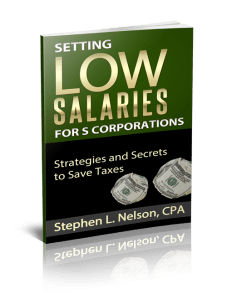S corporation shareholder-employees definitely need to make sure their salaries look reasonable. That’s the key point you want to take away from the relevant court cases like David E. Watson v. Internal Revenue Service.
Unfortunately, you probably want to do more than just verify your shareholder-employee wages are reasonable if you’re running an S corporation.
In my experience—and that of other CPAs who I talk to—the Internal Revenue Service also wants S corporation shareholders to receive reasonable distributions. Or more specifically, the IRS will also look carefully at distributions when it looks at wages to make sure not only that wages are reasonable but that distributions are not “unreasonably large.”
Definitely, therefore, an S corporation and its owners need to think about how to make distributions to shareholders appear both reasonable and modest.
Accordingly, to help you with that, I want to identify a handful of accounting and business tips that can reduce the appearance of unreasonably large distributions.
Tip #1: Don’t Start With a Pile a Cash from Self-employment Earnings
Here’s a first tip: Don’t start an S corporation using a pile of cash that comes from self-employment earnings you may later want to withdraw.
For example, you do not want to elect Subchapter S status for a business that’s previously been taxed as a sole proprietorship or for a business that’s previously been taxed as a partnership without first withdrawing any self-employment earnings still sitting in the business’s bank accounts.
Here’s why: If you have previously-taxed self-employment earnings sitting there in a business checking account at year end, elect Subchapter S status for the new year, and then withdraw the money, you have distributions the IRS may want to re-categorize as wages and then collect employment taxes on. Ouch.
By the way? Ultimately you should be able to get the IRS to agree it shouldn’t first levy a self-employment tax on self-employment earnings and then, when later withdrawing those earnings, levy Social Security and Medicare employment taxes on the same money.
But why risk even having this argument? Your best option is to not flag your return in the first place.
Tip #2: Leave Cash Inside the Business
A quick point: The IRS can make you re-categorize distributions as wages, then collect payroll taxes on the wages it’s created via re-categorization, and then levy penalties on the S corporation because it didn’t pay the payroll taxes in a timely fashion.
However, the IRS can’t make you pay wages or distributions.
Accordingly, you ought not to withdraw cash from an S corporation if you can help it. Any cash left inside your S corporation is safe from re-categorization.
Be sure, therefore, to keep your business’ emergency reserves inside the corporation. You may even want to keep your personal rainy day funds inside the corporation.
By building up your rainy day and emergency funds inside the corporation, you’ll automatically reduce your distributions and minimize your re-categorization risk.
Tip #3: Smooth Distributions
Okay, so I disagree with the idea that you should or need to use a formula that sets wages and distributions. The right approach according to the most recent court cases is to look at surveys and studies to come up with a reasonable wages number. That should mean that the distribution is what it is… and in a sense, irrelevant.
For example, I see only superficial logic in a formula that says “Well, you need to make sure that you take at least 60% of your profits as wages and no more than 40% of your profits as distributions.”
That said, as a practical matter, you might as well play the game and try to make your distributions look reasonable to any IRS agent employing a “wages and distributions” formula.
For example, say you have a corporation that makes $100,000 a year and that you pay $60,000 a year in wages. You would not want to hoard your cash for five years until the bank account sits at, say, $200,000. And then at that point, withdraw the money in a $200,000 lump sum distribution so, to an auditor, the situation looks extremely odd in year 5.
See the table that follows? Doesn’t that big distribution look suspicious? I kind of think it does, if I’m honest.
| Year | Profits | Wages | Distributions |
| 1 | $100,000 | $60,000 | $0 |
| 2 | $100,000 | $60,000 | $0 |
| 3 | $100,000 | $60,000 | $0 |
| 4 | $100,000 | $60,000 | $0 |
| 5 | $100,000 | $60,000 | $200,000 |
Better to smooth things out, drawing $60,000 annually in wages and $40,000 annually in distributions, so things look like this:
| Year | Profits | Wages | Distributions |
| 1 | $100,000 | $60,000 | $40,000 |
| 2 | $100,000 | $60,000 | $40,000 |
| 3 | $100,000 | $60,000 | $40,000 |
| 4 | $100,000 | $60,000 | $40,000 |
| 5 | $100,000 | $60,000 | $40,000 |
And here’s another example of where smoothing might help you out.
It seems to me that you might be able use smoothing in a situation where you have a giant spike in earnings, too. For example, say you usually earn $80,000 a year and pay $60,000 of this amount as wages and $20,000 of this amount as distributions.
If some year you earn $180,000 in profits rather than $80,000, for example, you might want to draw out the extra profits incrementally over five years so your distributions value (which appears on your tax return in plain sight) doesn’t pique the IRS computers’ interest. Look at the table below to see how this looks to you:
| Year | Profits | Wages | Distributions |
| 1 | $180,000 | $60,000 | $40,000 |
| 2 | $80,000 | $60,000 | $40,000 |
| 3 | $80,000 | $60,000 | $40,000 |
| 4 | $80,000 | $60,000 | $40,000 |
| 5 | $80,000 | $60,000 | $40,000 |
Tip #4: Show Healthcare Insurance and Health Savings Account Contributions Correctly
In many small Subchapter S corporations, if you account for health insurance and a health savings account correctly, the money for these expenses can in effect reduce your distributions.
For example, if you have $100,000 of profit and split this value into $40,000 of wages and $60,000 of distributions, that accounting might trigger a query from the IRS.
But say you pay $20,000 for health insurance and health savings account contributions using the money you receive as wages or as distributions.
If you don’t personally pay for your health insurance and HSA contribution, but instead pay for this stuff out of the corporation, this accounting essentially burns off distributions.
I describe how the accounting for this works here (see Example #1), but you can think of the health insurance and health savings account as amounting to tax-free fringe benefits.
In a situation where you show $40,000 in base shareholder-employee wages and show another $20,000 in shareholder-employee health insurance and HSA contributions, you would only have $40,000 leftover to even distribute.
Tip #5: Use a SEP Pension Plan
Another quick tip: If possible, you ought to use a pension plan that “comes out” of the distributive share and distribution and not out of your wages.
Say you have an S corporation that makes $100,000, that you pay a shareholder a base salary of $40,000 and also provide $20,000 of health insurance and health savings account benefits.
In this case, you can make up to a $15,000 SEP-IRA contribution—and this money comes out of the distribution and not out of wages. (You can usually make a SEP-IRA contribution that’s as large as 25% of your base wages and correctly accounted for shareholder-employee healthcare benefits.)
And look at what’s happened here: If you take $100,000 of profits and burn off $40,000 in wages, $20,000 in healthcare benefits and $15,000 in SEP-IRA pension contributions, you’ve only got $25,000 of cash left to distribute.
That $25,000 will probably look reasonable to any auditor-especially if you’ve been good and rational about first setting the base shareholder-employee wages to a reasonable value.
Tip #6: Move Charitable Contributions to the S Corporation
One final tip applies to some taxpayers: If you’re someone who includes charitable giving in your personal or family budget and you own an S corporation, you ought to make the charitable contributions from the S corporation.
For example, rather than personally giving $5,000 to a local charity or house of worship, you ought to have your S corporation give the money instead.
This charitable gift reduces the distribution you receive.
Note that you will still, if you do the tax return for the S corporation correctly, end up putting the charitable contribution on your personal tax return. But by giving from the S corporation, you decrease the distribution.
Need Help Setting S Corporation Shareholder Salaries?
Before I close here, let me make a quick plug for my S corporation salaries ebook (priced at $37.95). To maximize the tax savings from an S corporation, you need to minimize the salary paid to shareholder employees. But without being unreasonable. That’s the trick, so to speak.
Accordingly, if you want help with this tax decision, you may also want to get and carefully read my short, easy-to-understand ebook, Setting Low Salaries for S Corporations. But do note: If you’re a CPA firm client, you don’t need to purchase this ebook. Just email us and ask for your complimentary copy.


What if you’ve already made the mistake you discuss in Tip#1, and you have a pile of cash in the company. Are you better off dribbling it out in reasonable amounts year after year, or leaving it there until you wind up the business? Are there any issues when you eventually close the business with distributing a big pile of cash?
I would say you dribble… though I will note that if you’re paying the FICA max or close to it and especially if you’re over the limit, you can distribute big dollar amounts without worrying about.
Steve,
By the FICA maximum, do you mean the $118K cutoff?
Thank you.
Yes.
I didn’t think I could do a SEP if I’m a w-2 employee of my S Corp (single owner). Are you saying I can? Would the contribution amount be based on my W-2 income, or on my S Corp profit?
Your S corp can set up a SEP… and then it can make contributions to your SEP and deduct on 1120S return as pension expenses.
Note that your SEP-IRA needs to operate within the rules. E.g., you can’t discriminate except in one of the “acceptable” ways such as based on age, years of service, coverage under a collective bargaining agreement, and so forth.
Reviving an old thread … what if I hold my share of a PLLC through an S corp in which I am the sole owner and employee?
Can I set up a SEP for myself, or must I participate in the same retirement plan that the PLLC has for its employees?
That works to save self-employment taxes. See this post:
https://evergreensmallbusiness.com/s-corporation-partnerships/
But your S corp is part of the controlled group of corporations that gets treated as a common employer. So the PLLC partnership retirement plan needs to be the one you use, too.
Hi Steve, I am reviewing this old post and have a question about smoothing S corp distributions. I read some articles by others saying that “even if you choose to leave some or all of the profits in the S Corp, taking nothing as distribution or salaries, you will still be required to pay tax on 100% of those profits.” Doesn’t this seem to contradicts to smoothing distributions?